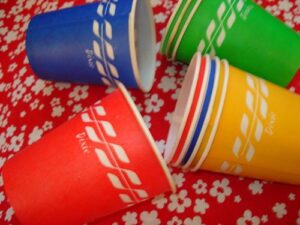 Here’s how my family went on trips when I was a child.
Here’s how my family went on trips when I was a child.
My daddy neatly arranged our suitcases in the trunk of our 1956 turquoise-and-white Plymouth sedan while my mother filled a brown paper grocery sack with pimento cheese sandwiches, tuna salad sandwiches and peanut butter-and-jelly sandwiches, each sandwich wrapped neatly as a present in crisp wax paper. She added a big bag of Fritos, green grapes in a green Tupperware bowl and a package of Oreo cookies. Last but not least, into the sack went a handful of paper napkins and exactly four Dixie paper cups—one yellow (Mother’s), one green (Daddy’s), one red (my brother Rusty’s) and one blue (mine). We drank from these cups the entire trip. The food sack rode on the floor of the back seat, along with a two-gallon metal Thermos jug filled with ice water. We could drink from the lid of the Thermos if something happened to any of the Dixie cups.
No matter how far we went or how many stops we made to gas up and use the restroom along the way, Daddy would let us buy only one Coke each on the entire trip. The drink might actually be a Seven-Up or a Dr. Pepper or an Orange Crush or even a Pepsi, but it would be called a Coke anyway. We had to drink the whole thing while we at the filling station because (1) Daddy didn’t want to pay a deposit on the glass bottles (2) He didn’t want the glass bottles to roll around on the floor of the car and clink together and perhaps break. When we reached our destination, we threw away the wax paper from the sandwiches and stored any of the go-withs that were left—and our Dixie cups, of course—in the brown paper sack.
In those days, as all of us who lived through them know, fast food restaurants were few and far between. And “single-use containers” weren’t really a thing.
Oh what a difference sixty years makes. Lunch on the road these days is almost always burgers and fries or chicken nuggets and fries along with a carbonated drink in a giant cup with a plastic lid and plastic straw. Fast food makes for lots of trash, which is all too often tossed out a car window. Nowadays, shoppers pile grocery buggies high with water bottled in plastic and soft drinks bottled in plastic and Styrofoam plates and Styrofoam cups and plastic utensils and a whole lot of other waste that will almost certainly wind up, if not on the side of the road or in a body of water, in an already-bursting landfill.
As we close out April, during which I’ve celebrated both Earth Day and Poetry Month in this column, I’ll finish with a poem by a writer I’d never heard of until I googled “poems about plastic.” He’s British and writes under the pseudonym Brian Bilston, but his real name is Paul Millicheap. Known as “The Poet Laureate of Twitter,” he’s apparently built a large following of fans by sharing his verse on social media. Here’s a portion of his 2018 poem entitled “Castaway”:
A bottle with a message floated in upon the tide.
The sea is blue and so am I, said the note inside
In the kelp, a cry for help, drowning in Styrofoam
Written on a coffee cup, beneath Latte 4 Jerome.
Two weeks on, the beach was plastic.
Itself, an unanswered message:
Castaways washed up on the sand,
And out to sea, the wreckage.
The poem isn’t just a cautionary tale. It’s reality. It’s truth. As we celebrate both poetry and Mother Earth this spring, may we take its message to heart.
(April 30, 2022)